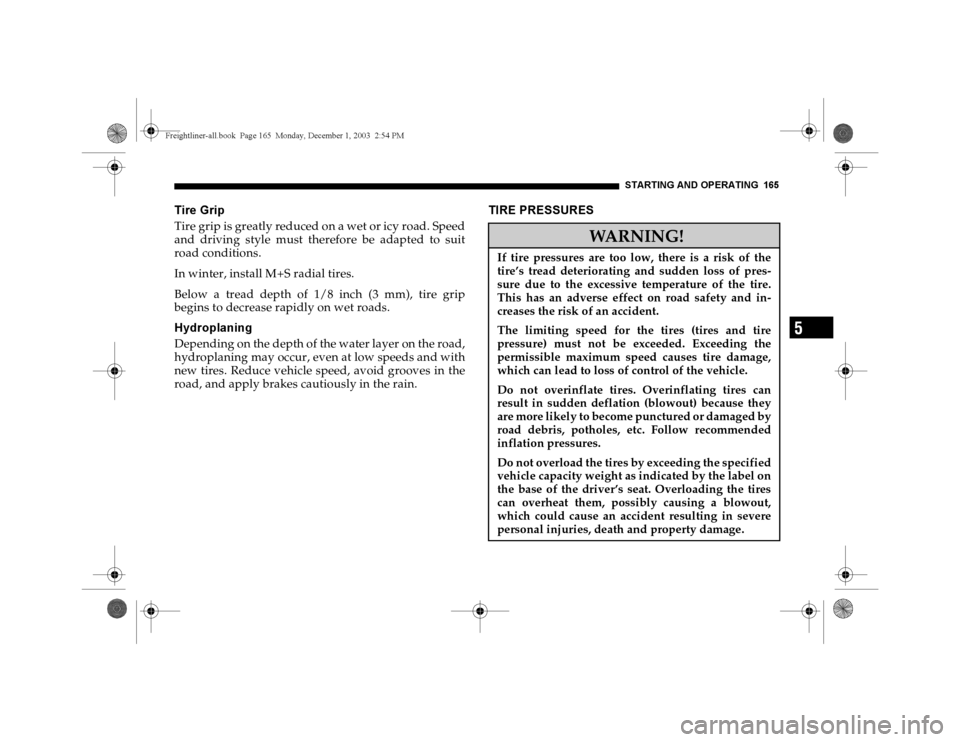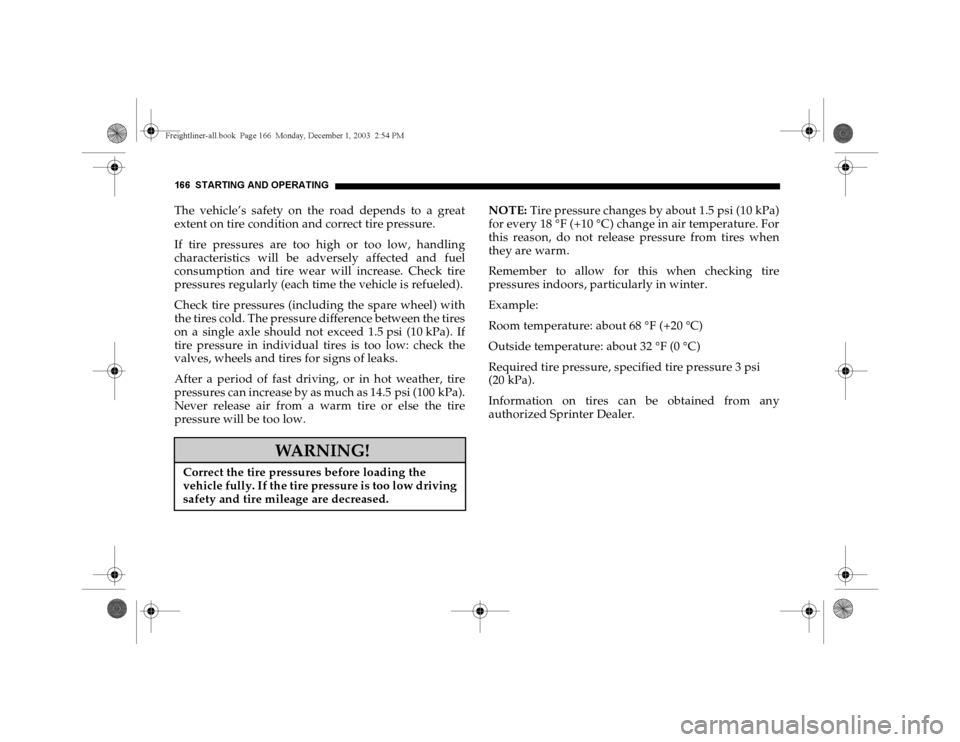2004 DODGE SPRINTER winter tires
[x] Cancel search: winter tiresPage 151 of 272

STARTING AND OPERATING 151
5
Driving SystemsThe vehicle can be equipped with the following
Driving Safety Systems:
Anti-lock brake system (ABS)
Electronic brake force distribution (EBV)
Acceleration skid control (ASR)
Brake assist system (BAS)
1
Electronic stability program (ESP)
1
NOTE: The maximum effectiveness of ABS, EBV, ASR
and ESP is only achieved if you drive with correct tire
pressures and adjust tire pressures to correspond with
the vehicle’s load. In winter operation, the maximum
effectiveness of the ABS and the ESP is only achieved
with winter tires (M+S tires), or snow chains as
required.
WARNING!
When leaving the vehicle always remove the key
from the ignition lock, and lock your vehicle.
Do not leave children unsupervised in the vehicle,
even if they are secured by a child restraint
system. The children could
injure themselves on parts of the vehicle
release the child-proof locks by pressing the
central locking button and could thereby open
the doors and
cause injury to others as a result
get out of the vehicle and could either injure
themselves when doing so or they could be
injured by the traffic approaching from the rear
suffer serious or fatal effects in the event of long
periods of hot weather
release the parking brake. The vehicle could
then start moving of its own accord.Unsupervised use of vehicle equipment may cause
severe personal injuries, death and property damage.
Freightliner-all.book Pag e 151 Monday, December 1, 2003 2:54 PM
Page 165 of 272

STARTING AND OPERATING 165
5
Tire GripTire grip is greatly reduced on a wet or icy road. Speed
and driving style must therefore be adapted to suit
road conditions.
In winter, install M+S radial tires.
Below a tread depth of 1/8 inch (3 mm), tire grip
begins to decrease rapidly on wet roads.HydroplaningDepending on the depth of the water layer on the road,
hydroplaning may occur, even at low speeds and with
new tires. Reduce vehicle speed, avoid grooves in the
road, and apply brakes cautiously in the rain.
TIRE PRESSURES
WARNING!
If tire pressures are too low, there is a risk of the
tire’s tread deteriorating and sudden loss of pres-
sure due to the excessive temperature of the tire.
This has an adverse effect on road safety and in-
creases the risk of an accident.
The limiting speed for the tires (tires and tire
pressure) must not be exceeded. Exceeding the
permissible maximum speed causes tire damage,
which can lead to loss of control of the vehicle.
Do not overinflate tires. Overinflating tires can
result in sudden deflation (blowout) because they
are more likely to become punctured or damaged by
road debris, potholes, etc. Follow recommended
inflation pressures.
Do not overload the tires by exceeding the specified
vehicle capacity weight as indicated by the label on
the base of the driver’s seat. Overloading the tires
can overheat them, possibly causing a blowout,
which could cause an accident resulting in severe
personal injuries, death and property damage.
Freightliner-all.book Pag e 165 Monday, December 1, 2003 2:54 PM
Page 166 of 272

166 STARTING AND OPERATINGThe vehicle’s safety on the road depends to a great
extent on tire condition and correct tire pressure.
If tire pressures are too high or too low, handling
characteristics will be adversely affected and fuel
consumption and tire wear will increase. Check tire
pressures regularly (each time the vehicle is refueled).
Check tire pressures (including the spare wheel) with
the tires cold. The pressure difference between the tires
on a single axle should not exceed 1.5 psi (10 kPa). If
tire pressure in individual tires is too low: check the
valves, wheels and tires for signs of leaks.
After a period of fast driving, or in hot weather, tire
pressures can increase by as much as 14.5 psi (100 kPa).
Never release air from a warm tire or else the tire
pressure will be too low.NOTE: Tire pressure changes by about 1.5 psi (10 kPa)
for every 18
°F (+10
°C) change in air temperature. For
this reason, do not release pressure from tires when
they are warm.
Remember to allow for this when checking tire
pressures indoors, particularly in winter.
Example:
Room temperature: about 68
°F (+20
°C)
Outside temperature: about 32
°F (0
°C)
Required tire pressure, specified tire pressure 3 psi
(20 kPa).
Information on tires can be obtained from any
authorized Sprinter Dealer.
WARNING!
Correct the tire pressures before loading the
vehicle fully. If the tire pressure is too low driving
safety and tire mileage are decreased.
Freightliner-all.book Pag e 166 Monday, December 1, 2003 2:54 PM
Page 215 of 272

MAINTAININ G YOUR VEHICLE 215
7
(1.5 cm) above the base area which is visible
through the filler opening.
Replace and tighten the radiator cap.
If a large quantity of coolant has been lost, or if smaller
amounts are lost at regular intervals, have the engine
cooling system examined by an authorized Sprinter
Dealer.
For coolant composition and water quality, contact
your Sprinter Dealer.
WINTER OPERATIONHave your vehicle winterized by an authorized
Sprinter Dealer before the onset of winter.
Have the engine oil changed, if the engine oil filled
is not approved for winter use.
Coolant: antifreeze/anti-corrosion concentration in
the coolant checked.
Windshield washer system: add winter concentrate
to the washer fluid.
Battery: the battery will lose capacity as
temperatures drop. Only a well-charged battery will
ensure reliable engine starting even at low outside
temperatures.
Tires: fit M+S radial tires, taking note of the
maximum permissible speed of the tires fitted.
Freightliner-all.book Pag e 215 Monday, December 1, 2003 2:54 PM
Page 272 of 272

272 INDEXUsing the Jack. . . . . . . . . . . . . . . . . . . . . . . . . . . . . . . . 193VVehicle / Engine Emission Label . . . . . . . . . . . . . . . . . 6
Vehicle Alteration . . . . . . . . . . . . . . . . . . . . . . . . . . . . 184
Vehicle and Trailer Weights. . . . . . . . . . . . . . . . . . . . 178
Vehicle Identification Number . . . . . . . . . . . . . . . . . . . 5
Vehicle Loading . . . . . . . . . . . . . . . . . . . . . . . . . . . . . . 144
Vehicle Safety Certification Label . . . . . . . . . . . . . . . . . 5
Vehicle Tool Kit . . . . . . . . . . . . . . . . . . . . . . . . . . . . . . 187
Vehicle Washing . . . . . . . . . . . . . . . . . . . . . . . . . . . . . 222
Ventilation . . . . . . . . . . . . . . . . . . . . . . . . . . . . . . . . . . 110
Ventilation, Heating . . . . . . . . . . . . . . . . . . . . . . . . . . 109WWading Capability . . . . . . . . . . . . . . . . . . . . . . . . . . . 183
Warnings and Cautions . . . . . . . . . . . . . . . . . . . . . . . . . 4
Warranty Information . . . . . . . . . . . . . . . . . . . . . . . . . 259Water in Fuel Indicator Lamp . . . . . . . . . . . . . . . . . . . 96
Wheels and Tires . . . . . . . . . . . . . . . . . . . . . . . . . . . . . 163
Window Cleaning . . . . . . . . . . . . . . . . . . . . . . . . . . . . 223
Window Operation . . . . . . . . . . . . . . . . . . . . . . . . . . . . 68
Electric . . . . . . . . . . . . . . . . . . . . . . . . . . . . . . . . . . . . 68
Mechanical . . . . . . . . . . . . . . . . . . . . . . . . . . . . . . . . . 68
Windows
De-Fogging. . . . . . . . . . . . . . . . . . . . . . . . . . . . . . . . 112
De-Icing . . . . . . . . . . . . . . . . . . . . . . . . . . . . . . . . . . 112
Windshield Heater. . . . . . . . . . . . . . . . . . . . . . . . . . . . 114
Windshield Washer System Fluid Reservoir . . . . . . 209
Windshield Wiper Switch. . . . . . . . . . . . . . . . . . . . . . . 69
Windshield wipers with rain sensor . . . . . . . . . . . . . . 70
Winter Operation . . . . . . . . . . . . . . . . . . . . . . . . . . . . . 215Freightliner-all.book Pag e 272 Monday, December 1, 2003 2:54 PM